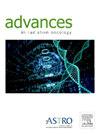标准剂量与减少剂量单组分脑转移瘤切除术前放疗(PROPS-BM)国际多中心队列研究
IF 2.7
Q3 ONCOLOGY
引用次数: 0
摘要
单组分术前立体定向放射手术(SRS)历来使用10%至20%的剂量减少标准剂量。然而,这种剂量减少的影响并没有很好地表征。本研究的目的是比较标准剂量(SD)和减少剂量(RD)单组分术前SRS的结果和毒性。方法和材料来自8个机构的国际多中心联合前瞻性和回顾性脑转移瘤术前放射手术(PROPS-BM)登记,其中至少有1个≤4 cm的实体癌脑转移患者接受了单次术前SRS治疗并进行了计划切除。根据机构给药实践,SD先验定义为≤2 cm病变≥20 Gy, 2 ~ 3 cm病变≥17 Gy, 3 ~ 4 cm病变≥14 Gy。进行了多变量和倾向评分匹配分析。结果该队列包括307例患者,术前SRS治疗了307例指数病变。124例(40%)患者使用SD, 183例(60%)患者使用RD。病变0 ~ 2 cm (n = 73)、2 ~ 3 cm (n = 152)、3 ~ 4 cm (n = 82)的中位剂量在SD组分别为20、18、15 Gy,在RD组分别为16、15、13 Gy。2年腔内局部复发(LR, 16%对15%,P = 0.69)、不良放射反应(ARE, 8%对6%,P = 0.77)、脑膜疾病(2%对8%,P = 0.07)、腔内LR、ARE或结节性脑膜疾病的复合终点(23%对22%,P = 0.86)或总生存率(49%对36%,P = 0.15)均无差异。在每个特定病变直径亚组和倾向评分匹配的队列中,结果相似(n = 168)。结论SD和RD单组分术前SRS均具有良好的腔内LR和ARE率。与SRS剂量类别无关,随病灶大小增大,腔内LR风险增加。在疗效或毒性方面,RD似乎没有SD单组分术前SRS的优势。需要进一步的研究来优化术前SRS剂量和分离。本文章由计算机程序翻译,如有差异,请以英文原文为准。
Standard Dose Versus Reduced Dose Single Fraction Preoperative Radiosurgery for Resected Brain Metastases (PROPS-BM) International Multicenter Cohort Study
Purpose
Single fraction preoperative stereotactic radiosurgery (SRS) has historically used a 10% to 20% dose reduction standard dosing. However, the effects of this dose reduction are not well characterized. The goal of this study was to compare outcomes and toxicity of standard dose (SD) with reduced dose (RD) single fraction preoperative SRS.
Methods and Materials
Patients with brain metastases from solid cancers, of which at least 1 lesion measuring ≤ 4 cm was treated with single fraction preoperative SRS and underwent planned resection were included from the Preoperative Radiosurgery for Brain Metastases (PROPS-BM international multicenter combined prospective and retrospective registries from 8 institutions. SD was a priori defined as ≥20 Gy for lesions ≤2 cm, ≥17 Gy for >2 to 3 cm, and ≥14 Gy for >3 to 4 cm based on institutional dosing practices. Multivariable and propensity score matched analyses were performed.
Results
The cohort consisted of 307 patients with 307 preoperative SRS treated index lesions. SD was used in 124 patients (40%) and RD was used in 183 patients (60%). Median dose for lesions 0 to 2 cm (n = 73), >2 to 3 cm (n = 152), and >3 to 4 cm (n = 82) was 20, 18, and 15 Gy in the SD cohort and 16, 15, and 13 Gy in the RD cohort, respectively. There was no difference in 2-year cavity local recurrence (LR, 16% vs 15%, P = .69), adverse radiation effect (ARE, 8% vs 6%, P = .77), meningeal disease (2% vs 8%, P = .07), composite endpoint of cavity LR, ARE, or nodular meningeal disease (23% vs 22%, P = .86), or overall survival (49% vs 36%, P = .15). Results were similar within each specific lesion diameter subgroup and within the propensity score matched cohorts (n = 168).
Conclusions
Both SD and RD single fraction preoperative SRS demonstrate excellent rates of cavity LR and ARE. Cavity LR risk increased with larger lesion size, regardless of SRS dose category. There does not seem to be an advantage in efficacy or toxicity for RD over SD single fraction preoperative SRS. Additional studies are warranted to optimize preoperative SRS dose and fractionation.
求助全文
通过发布文献求助,成功后即可免费获取论文全文。
去求助
来源期刊

Advances in Radiation Oncology
Medicine-Radiology, Nuclear Medicine and Imaging
CiteScore
4.60
自引率
4.30%
发文量
208
审稿时长
98 days
期刊介绍:
The purpose of Advances is to provide information for clinicians who use radiation therapy by publishing: Clinical trial reports and reanalyses. Basic science original reports. Manuscripts examining health services research, comparative and cost effectiveness research, and systematic reviews. Case reports documenting unusual problems and solutions. High quality multi and single institutional series, as well as other novel retrospective hypothesis generating series. Timely critical reviews on important topics in radiation oncology, such as side effects. Articles reporting the natural history of disease and patterns of failure, particularly as they relate to treatment volume delineation. Articles on safety and quality in radiation therapy. Essays on clinical experience. Articles on practice transformation in radiation oncology, in particular: Aspects of health policy that may impact the future practice of radiation oncology. How information technology, such as data analytics and systems innovations, will change radiation oncology practice. Articles on imaging as they relate to radiation therapy treatment.
 求助内容:
求助内容: 应助结果提醒方式:
应助结果提醒方式:


